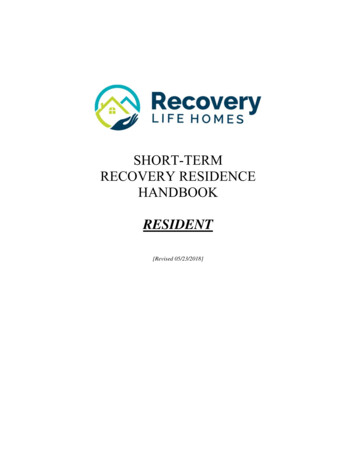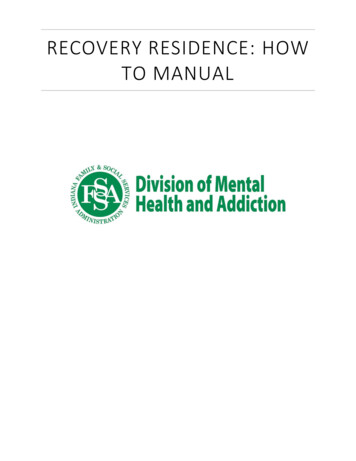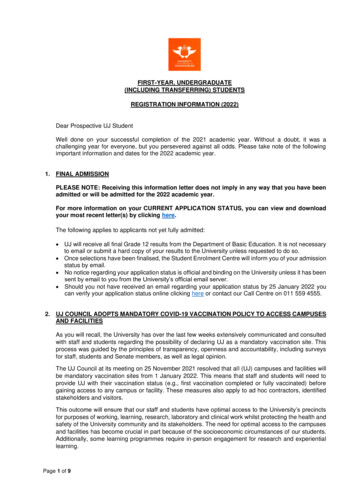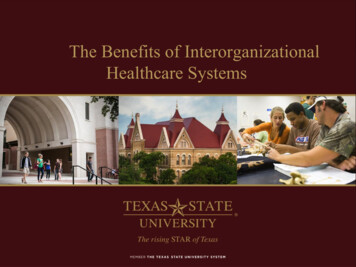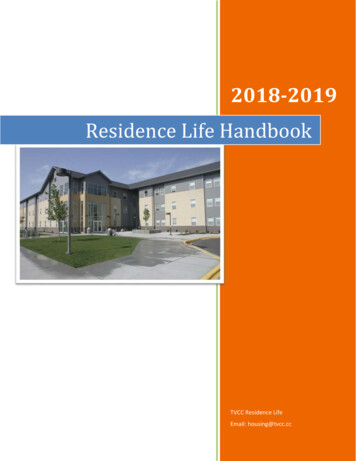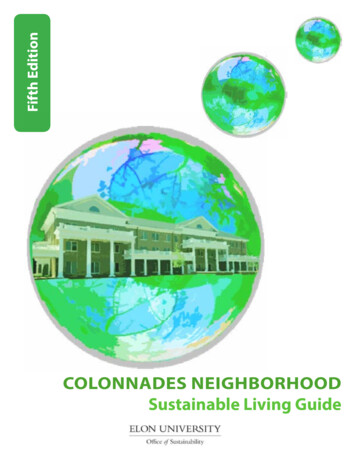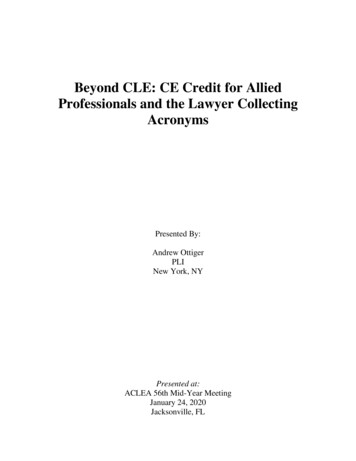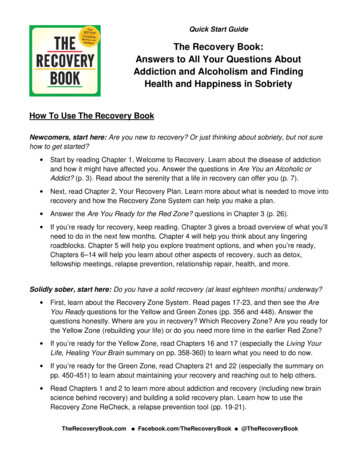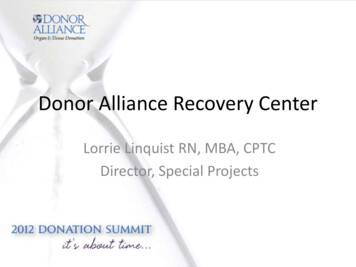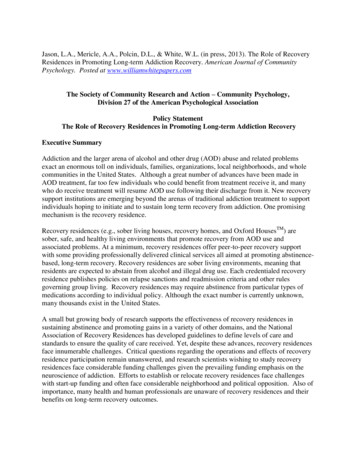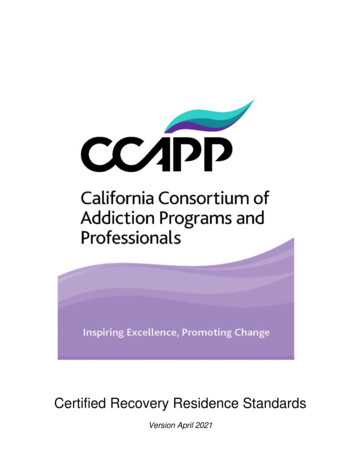
Transcription
Certified Recovery Residence StandardsVersion April 2021
Welcome to Recovery Residence Certification with CCAPP“Recovery residence” is a term generally used to describe a specific type of housing. Recoveryresidences, also known as sober living environments, offer a housing alternative to individuals whoare recovering from alcohol and or drug addiction. Other terms used to describe such housing are“cooperative housing for recovering people," "resident-run housing," "sober cooperative living,""alcohol, drug free living centers," “congregate living communities,” as well as others. All of thesearrangements have something in common in that they are intended for cooperative living of individualswho are recovering from alcoholism or drug addiction. In California, these residences are not subjectto licensing by any state agency, but may voluntarily choose to adopt national standards by certifyingwith CCAPP.Resident responsibility for the environment sets it apart from formal treatment programs. Thereis a great need for quality recovery residence housing in our communities. Experience has shown thatpersons who have completed a residential program of recovery or have stabilized in AlcoholicsAnonymous need to live in a recovery environment in order to maintain sobriety and recovery. Manypersons who leave organized programs do not have a home to go to, nor can they afford individualhousing, which is recovery conducive. Cooperative housing offers a bridge to independent living.Recovery Residences come in all sizes and configurations - from freestanding homes to apartmentbuildings.Any number of people may live in a recovery residence as long as local regulations regardingsquare footage for living space are not exceeded. People who are not related to each other andchoose to live together as a family do not need obtain a permit from the governing district in whichthey live; they are protected by state and federal law from discriminatory zoning requests that mayviolate fair housing and disability laws. Some local jurisdictions will require certain health and safetyrequirements for any type of rental property which may require a recovery residence owner oroperator to comply with. These are not considered discriminatory and must be followed.Recovery residences must be cognizant of state licensing laws for addiction treatment. Theymust not require residents to attend programs or counseling sessions, however certain rules may beset as provisions of residency. House rules may include curfew, smoking, chores, payment of rent,and attendance at house meetings, and A.A./N.A. meetings, and must include prohibition of any useof alcohol and or illicit drugs. A recovery residence may or may not have paid staff. The role of thestaff must be clearly for management of the housing and not for management of individuals (clinical).The environment must be recovery conducive and space should be adequate to accommodate eachCertified Recovery Residence Standards – April 2021California Consortium of Addiction Programs and Professionals
individual comfortably and with dignity and respect.Outline of StandardsCCAPP uses standards approved by the National Alliance for Recovery Resources (NARR) to certifyresidences. NARR created standards for four levels of residences. CCAPP certifies recovery residencesat Level 2. By request, CCAPP may also certify a Level 1 residence (typically Oxford House models).CCAPP does not certify level 3 or 4 residences as clinical services are provided in them which wouldrequire licensure as an alcohol drug treatment program in California. Following are tables whichdetail Level 2 requirements that are used to determine certification status for CCAPP RecoveryResidences. Numbering may not appear sequential as levels 3 and 4 are deleted.Domain 1Principle A.Administrative OperationsOperate with integrity: Standards 1-4Principle B.Uphold residents’ rights: Standards 5 and 6Principle C.Create a culture of empowerment where residents engage in governance and leadership:Standards 7 and 8Principle D.Develop staff abilities to apply the Social Model: Standards 9-13Domain 2Principle E.Physical EnvironmentProvide a home-like environment: Standards 14 and 15Principle F.Promote a safe and healthy environment: Standards 16-19Domain 3Principle G.Recovery SupportFacilitate active recovery and recovery community engagement: Standards 20-23Principle H.Model prosocial behaviors and relationship enhancement skills: Standard 24Principle I.Cultivate the resident’s sense of belonging and responsibility for community:Standards 25-27Domain 4Principle J.Good NeighborBe a good neighbor: Standards 28 and 29Certified Recovery Residence Standards – April 2021California Consortium of Addiction Programs and Professionals
Domains, Core Principles and StandardsAdministrative and Operational Domain1A.Core Principle: Operate with IntegrityUse mission and vision as guides for decision making1.a.A written mission that reflects a commitment to those served and identifies the populationserved which, at a minimum, includes persons in recovery from a substance use disorder.b.A vision statement that is consistent with NARR’s core principles.Adhere to legal and ethical codes and use best business practices2.a.b.Documentation of legal business entity (e.g. incorporation, LLC documents or businesslicense).Documentation that the owner/operator has current liability coverage and other insuranceappropriate to the level of support.c.Written permission from the property owner of record (if the owner is other than therecovery residence operator) to operate a recovery residence on the property.d.A statement attesting to compliance with nondiscriminatory state and federal requirements.e.Operator attests that claims made in marketing materials and advertising will be honest andsubstantiated and that it does not employ any of the following: False or misleading statements or unfounded claims or exaggerations; Testimonials that do not reflect the real opinion of the involved individual;Price claims that are misleading; Therapeutic strategies for which licensure and/or counseling certifications are requiredbut not applicable at the site; orMisleading representation of outcomes. f.Policy and procedures that ensure the following conditions are met if the residence provideremploys, contracts with or enters into a paid work agreement with residents: Paid work arrangements are completely voluntary. Residents do not suffer consequences for declining work. Residents who accept paid work are not treated more favorably than residents who donot. All qualified residents are given equal opportunity for available work. Paid work for the operator or staff does not impair participating residents’ progresstowards their recovery goals. The paid work is treated the same as any other employment situation. Wages are commensurate with marketplace value and at least minimum wage. The arrangements are viewed by a majority of the residents as fair. Paid work does not confer special privileges on residents doing the work. Work relationships do not negatively affect the recovery environment or morale of thehome.Certified Recovery Residence Standards – April 2021California Consortium of Addiction Programs and Professionals
g.Staff must never become involved in residents’ personal financial affairs, including lendingor borrowing money, or other transactions involving property or services, except that theoperator may make agreements with residents with respect to payment of fees.h.A policy and practice that provider has a code of ethics that is aligned with the NARR codeof ethics. There is evidence that this document is read and signed by all those associatedwith the operation of the recovery residence, to include owners, operators, staff andvolunteers.Be financially honest and forthright3.a.b.c.d.Prior to the initial acceptance of any funds, the operator must inform applicants of all feesand charges for which they will be, or could potentially be, responsible. This informationneeds to be in writing and signed by the applicant.Use of an accounting system which documents all resident financial transactions such asfees, payments and deposits. Ability to produce clear statements of a resident’s financial dealings with the operatorwithin reasonable timeframes. Accurate recording of all resident charges and payments. Payments made by 3rd party payers are notedA policy and practice documenting that a resident is fully informed regarding refund policiesprior to the individual entering into a binding agreement.A policy and practice that residents be informed of payments from 3 rd party payers for anyfees paid on their behalf.Collect data for continuous quality improvement4.a.B.Unsatisfactory work relationships are terminated without recriminations that can impairrecovery.Policies and procedures regarding collection of resident’s information. At a minimum datacollection will Protect individual’s identity. Be used for continuous quality improvement and Be part of day-to-day operations and regularly reviewed by staff and residents (whereappropriate).Core Principle: Upholding Residents’ RightsCommunicate rights and requirements before agreements are signed5.a.Documentation of a process that requires a written agreement prior to committing to termsthat includes the following: Resident rights Financial obligations, and agreements Services provided Recovery goals Relapse policies Policies regarding removal of personal property left in the residenceProtect resident information6.a.b.c.Policies and procedures that keep residents’ records secure, with access limited toauthorized staff.Policies and procedures that comply with applicable confidentiality laws.Policies and procedures, including social media, protecting resident and community privacyand confidentiality.Certified Recovery Residence Standards – April 2021California Consortium of Addiction Programs and Professionals
Core Principle: Create a culture of empowerment where residents engage ingovernance and leadershipC.Involve residents in governance7.a.b.c.Verification that written resident’s rights and requirements (e.g. residence rules andgrievance process) are posted or otherwise available in common areas.d.Policies and procedures that promote resident-driven length of stay.e.Evidence that residents have opportunities to be heard in the governance of the residence;however, decision making remains with the operator.Promote resident involvement in a developmental approach to recovery8.a.b.c.D.Evidence that some rules are made by the residents that the residents (not the staff)implement.Grievance policy and procedures, including the right to take unresolved grievances to theoperator’s oversight organization.Peer support interactions among residents are facilitated to expand responsibilities forpersonal and community recovery.Written responsibilities, role descriptions, guidelines and/or feedback for residence leaders.Evidence that residents’ recovery progress and challenges are recognized and strengths arecelebrated.Core Principle: Develop Staff Abilities to Apply the Social ModelStaff model and teach recovery skills and behaviors9.a.Evidence that management supports staff members maintaining self-care.b.Evidence that staff are supported in maintaining appropriate boundaries according to acode of conduct.Evidence that staff are encouraged to have a network of support.c.d.Evidence that staff are expected to model genuineness, empathy, respect, support andunconditional positive regard.Ensure potential and current staff are trained or credentialed appropriate to theresidence level10.a.Policies that value individuals chosen for leadership roles who are versed and trained in theSocial Model of recovery and best practices of the profession.b.Policies and procedures for acceptance and verification of certification(s) when appropriate.Staff are culturally responsive and competent11.a.b.Policies and procedures that serve the priority population, which at a minimum includepersons in recovery from substance use but may also include other demographic criteria.Cultural responsiveness and competence training or certification are provided.All staff positions are guided by written job descriptions that reflect recovery12.a.Job descriptions include position responsibilities and certification/licensure and/or livedexperience credential requirements.b.Job descriptions require staff to facilitate access to local community-based resources.Certified Recovery Residence Standards – April 2021California Consortium of Addiction Programs and Professionals
c.Provide Social Model-Oriented Supervision of Staff13.2.Job descriptions include staff responsibilities, eligibility, and knowledge, skills and abilitiesneeded to deliver services.Ideally, eligibility to deliver services includes lived experience recovering from substanceuse disorders and the ability to reflect recovery principles.a.Policies and procedures for ongoing performance development of staff appropriate to staffroles and residence level.b.Evidence that supervisors (including top management) create a positive, productive workenvironment for staff.Physical Environment DomainE. Core Principle: Provide a Home-like EnvironmentThe residence is comfortable, inviting, and meets resident needs14.a.Verification that the residence is in good repair, clean, and well maintainedb.Verification that furnishings are typical of those in single family homes or apartments asopposed to institutional settings.c.Verification that entrances and exits are home‐like vs. institutional or clinical.d.e.Verification of 50 sq. ft per bed per sleeping room.Verification that there is a minimum of one sink, toilet and shower per six residents.f.g.Verification that each resident has personal item storage.Verification that each resident has food storage space.h.Verification that laundry services are accessible to all residents.i.Verification that all appliances are in safe, working condition.The living space is conducive to building community15.a.Verification that a meeting space is large enough to accommodate all residents.b.Verification that a comfortable group area provides space for small group activities andsocializingVerification that kitchen and dining area(s) are large enough to accommodate all residentssharing meals together.Verification that entertainment or recreational areas and/or furnishings promoting socialengagement are provided.c.d.F.Core Principle: Promote a Safe and Healthy EnvironmentProvide an alcohol and illicit drug free environment16.a.Policy prohibits the use of alcohol and/or illicit drug use or seeking.b.Policy lists prohibited items and states procedures for associated searches by staffc.Policy and procedures for drug screening and/or toxicology protocols.d.Policy and procedures that address residents’ prescription and non-prescription medicationusage and storage consistent with the residence’s level and with relevant state law.Certified Recovery Residence Standards – April 2021California Consortium of Addiction Programs and Professionals
e.Policies and procedures that encourage residents to take responsibility for their own andother residents’ safety and health.Promote Home Safety17.a.Operator will attest that electrical, mechanical, and structural components of the propertyare functional and free of fire and safety hazards.Operator will attest that the residence meets local health and safety codes appropriate to thetype of occupancy (e.g. single family or other) OR provide documentation from agovernment agency or credentialed inspector attesting to the property meeting health andsafety standards.b.c.Verification that the residence has a safety inspection policy requiring periodicverification of Functional smoke detectors in all bedroom spaces and elsewhere as code demands, Functional carbon monoxide detectors, if residence has gas HVAC, hot water orappliances Functional fire extinguishers placed in plain sight and/or clearly marked locations, Regular, documented inspections of smoke detectors, carbon monoxide detectors and fireextinguishers, Fire and other emergency evacuation drills take place regularly and are documented (notrequired for Level I Residences). Fire escape ladder required for each level in a multi-story home if the home as only onestaircase leading to upper level(s).Promote Health18.a.Policy regarding smoke‐free living environment and/or designated smoking area outside ofthe residence.Policy regarding exposure to bodily fluids and contagious disease.b.Plan for emergencies including intoxication, withdrawal and overdose19.a.b.Verification that emergency numbers, procedures (including overdose and other emergencyresponses) and evacuation maps are posted in conspicuous locations.Documentation that emergency contact information is collected from residents.c.Documentation that residents are oriented to emergency procedures.d.Verification that Naloxone is accessible at each location, and appropriate individuals areknowledgeable and trained in its use.3.Recovery Support DomainCore Principle: Facilitate Active Recovery and Recovery Community EngagementG.Promote meaningful activities20.a. Documentation that residents are encouraged to do at least one of the following: Work, go to school, or volunteer outside of the residence (Level 1, 2 and some 3s)Participate in mutual aid or caregiving (All Levels)Participate in social, physical or creative activities (All Levels)Participate in daily or weekly community activities (All Levels)Participate in daily or weekly programming (Level 3’s and 4’s)Engage residents in recovery planning and development of recovery capital21.a.b.Evidence that each resident develops and participates in individualized recovery planningthat includes an exit plan/strategyEvidence that residents increase recovery capital through such things as recovery supportand community service, work/employment, etc.Certified Recovery Residence Standards – April 2021California Consortium of Addiction Programs and Professionals
c.Written criteria and guidelines explain expectations for peer leadership and mentoring roles.Promote access to community supports22.a.Resource directories, written or electronic, are made available to residents.b.Staff and/or resident leaders educate residents about local community-based resources.Provide mutually beneficial peer recovery support23.a.A weekly schedule details recovery support services, events and activities.b.Evidence that resident-to resident peer support is facilitated: Evidence that residents are taught to think of themselves as peer supporters for othersin recovery. Evidence that residents are encouraged to practice peer support interactions withother residents.Core Principle: Model Prosocial Behaviors and RelationshipEnhancement SkillsH.Maintain a respectful environment24.a.Evidence that staff and residents model genuineness, empathy and positive regard.b.Evidence that mechanisms exist for residents to inform and help guide operations andadvocate for community-building.Core Principle: Cultivate the Resident’s Sense of Belonging and Responsibility forCommunityI.25.26.Sustain a “functionally equivalent family” within the residence by meeting at least50% of the following:a.Residents are involved in food preparation.b.Residents have a voice in determining with whom they live.c.Residents help maintain and clean the home (chores, etc.).d.Residents share in household expenses.e.Community or residence meetings are held at least once a week.f.Residents have access to common areas of the home.Foster ethical, peer-based mutually supportive relationships among residents andstaffa.Engagement in informal activities is encouraged.b.Engagement in formal activities is required.c.27.Community gatherings, recreational events and/or other social activities occurperiodically.d.Transition (e.g. entry, phase movement and exit) rituals promote residents' sense ofbelonging and confer progressive status and increasing opportunities within therecovery living environment and community.Connect residents to the local communitya.Residents are linked to mutual aid, recovery activities and recovery advocacy opportunities.Certified Recovery Residence Standards – April 2021California Consortium of Addiction Programs and Professionals
b.c.d.e.f.Residents find and sustain relationships with one or more recovery mentors or mutual aidsponsors.Residents attend mutual aid meetings or equivalent support services in the community.Documentation that residents are formally linked with the community such as job search,education, family services, health and/or housing programs.Documentation that resident and staff engage in community relations and interactions topromote kinship with other recovery communities and goodwill for recovery services.Residents are encouraged to sustain relationships inside the residence and with others in theexternal recovery community4.Good Neighbor DomainJ.Core Principle: Be a Good NeighborBe responsive to neighbor concerns28.a.b.c.Policies and procedures provide neighbors with the responsible person’s contact informationupon request.Policies and procedures that require the responsible person(s) to respond to neighbor’sconcerns.Resident and staff orientations include how to greet and interact with neighbors and/orconcerned parties.Have courtesy rules29.a.b.Preemptive policies address common complaints regarding at least: Smoking Loitering Lewd or offensive language Cleanliness of the propertyParking courtesy rules are documented.Certified Recovery Residence Standards – April 2021California Consortium of Addiction Programs and Professionals
housing, which is recovery conducive. Cooperative housing offers a bridge to independent living. Recovery Residences come in all sizes and configurations - from freestanding homes to apartment buildings. Any number of people may live in a recovery residence as long as local regulations regarding square footage for living space are not exceeded.
